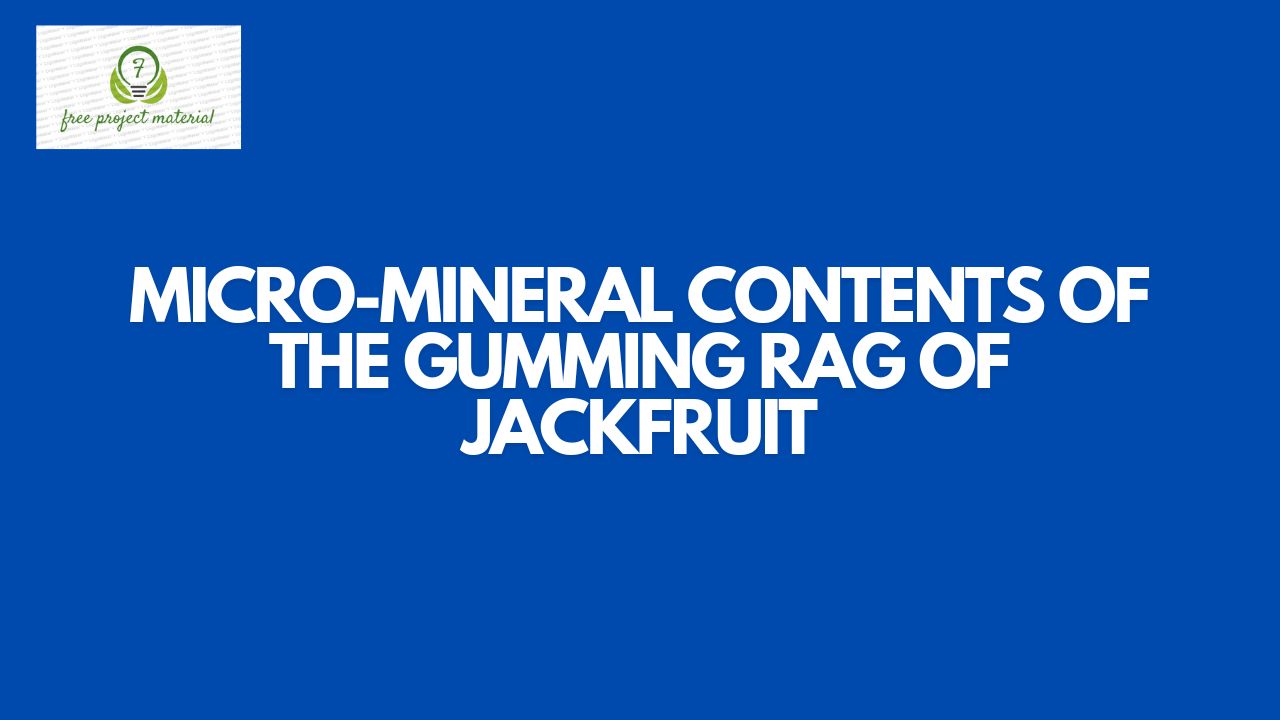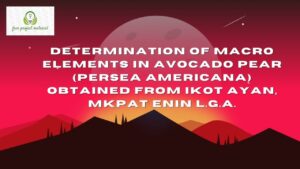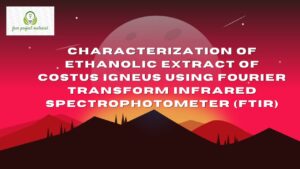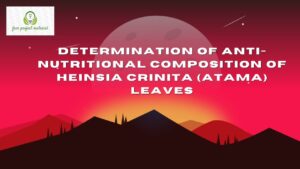ABSTRACT
The analysis for the mineral composition of the gumming rag of jackfruit was carried out using standard analytical method. The result of the analysis reveals that the sample contain all the analyzed mineral elements. Their concentration were as follows; cobalt 0.940±0.005 mg/100g, was greater than copper 0.032±0.004 mg/100g, iron 29.21±1.300 mg/100g was greater than manganese 0.113±0.158 mg/100g was greater than zinc 0.006±0.006 mg/100g, which means that zinc was less than the element concentration. Comparing the result with the Required Dietary Allowance (RDA) standard, it reveals that the sample is poor source of the analyzed minerals. This sample cannot be use alone for the purpose of nourishing a body with these minerals unless other higher sources of these minerals are added.
TABLE OF CONTENTS
Title Page- – – – – – – – – – i
Certification- – – – – – – – – ii
Dedication- – – – – – – – – – iii
Acknowledgements- — – – – – – – iv
Abstract- – – – – – – – – – v
Table of Contents- – – – – – – – – vi-viii
CHAPTER ONE: INTRODUCTION
1.1 Background of the Study- – – – – – 1-3
1.2 Aim and Objectives of the Study- – – – – 4
1.2.1 Aim- – – – – – – – – – 4
1.2.2 Objectives- – – – – – – – – 4
1.3 Scope and Limitation of the Study- – – – – 5
1.4 Definition of Terms- – – – – – – 5-6
CHAPTER TWO: LITERATURE REVIEW
2.1 Description of Jacktree and fruits- – – – – 7-10
2.2 Chemical Composition and Nutritional Value of Jackfruit- 10-12
2.3 Uses of Jackfruit- – – – – – – – 12-13
2.4 Health Benefit of Jackfruit- – – – – – 13-15
2.5 Reasons for Underutilization of Jackfruit- – – – 15-17
2.6 Uses of Different Part of Jackfruit- – – – – 17-19
2.7 Micro-minerals- – – – – – – – 19-20
2.7.1 Iron- – – – – – – – – – 20-21
2.7.2 Manganese- – – – – – – – – 21
2.7.3 Copper- – – – – – – – – 21-22
2.7.4 Zinc- – – – – – – – – – 22
CHAPTER THREE: MATERIALS AND METHODS
3.1 Equipment and Reagent- – – – – – – 23
3.2 Sample Collection and Preparation- – – – – 24
3.3 Analytical Procedures- – – – – – – 24-25
CHAPTER FOUR: RESULTS AND DISCUSSION
4.1 Results- – – – – – – – – 26
4.2 Discussion- – – – – – – – – 27-29
CHAPTER FIVE: CONCLUSION AND RECOMMENDATION
5.1 Conclusion- – – – – – – – – 30
5.2 Recommendation- – – – – – – – 30
References
CHAPTER ONE: INTRODUCTION
1.1 Background of the Study
Jackfruit is one of the commonly consumed foods in Sri Lanka from the ancient time. It is a non-seasonal fruit and had a major contribution to the food supply of the people and their livestock when there were short supplies of staple food grains (Sim et al., 2003).
Therefore, it is referred to as poorman’s food (Singh et al., 1963). It is a monoecious tree and both male and female inflorescences are found on the same tree (Bose and Morton, 1987). The fertilization is by cross-pollination and the propagation is mostly through seeds. The complete fruit development process takes about three to seven months from the pollination, varying in different countries (Baliga et al., 1811).
Jackfruit is considered to be originated in the rain forests of the Western Ghats in the Southwestern part of India, but some authors argue that Malaysia could be the possible centre of origin (Mowry et al., 1958). It is found in many parts of Asia, Africa, and South America (Jagadeesh et al., 2007). Jackfruit grows in warm and moist regions (Faria et al., 2009). The disposal of unutilized parts of fruits is a key environmental concern because of increased bio-waste accumulation.
The waste is considered a potential breeding ground for food-borne and water-borne pathogens (Feumba et al., 2016). According to Hoornweg et al. (2013), global waste is estimated to be 1.3 billion tons annually and may increase to 2.2 billion tonnes by 2025. The main sources of the bio-waste are factories, such as the fruit juice processing plants in the food industry that leave huge accumulation of unutilized parts of the fruits ( Asquieri et al., 2008).
Therefore, there is a need to recycle unutilized parts of fruits to prevent their bioaccumulation. Phytochemical compounds, essential elements, antioxidant and antimicrobial activities, have been isolated from unutilized parts of fruits found hence making them important to the food, agriculture and pharmaceutical industry (Al-Zoreky, 2009; Dorta et al., 2012; Geraci et al., 2016). Researches have confirmed that there are appreciable amounts of bioactive compounds in waste fruit parts (peels pomaces, seed and fiber) with potential benefits to human health and can also act as fungicides, bactericides and for disease control in agriculture (Al-Zoreky, 2009; Geraci et al., 2016).
Jackfruit (Artocarpus heterophyllus Lam) is a large and evergreen tree that can produce about 100 to 200 fruits in a year (Prakash et al., 2009). There have been limited studies on unutilized fruit parts of jackfruit. Jackfruit is the largest known edible fruit whose unutilized fruit parts include the peels, fiber and the core are the dominating part of the fruit (accounts for 60% of the entire fruit). It is clear that the edible pulp and seeds of ripe jackfruits are excellent sources of macronutrients and bioactive compounds.
The study of the unutilized parts of the fruit will encourage utilization of the waste parts of the fruits, which will contribute in reducing bio-waste accumulation with the dual aim value addition to jackfruit waste as well as management of pathogenic bacteria in crop plants.
1.2 Aim and Objectives of the Study
1.2.1 Aim
The aim of this study is to determine the micro-mineral contents of the gumming rag component of jackfruit.
1.2.2 Objectives
The objectives were as follows
- The jackfruit was obtained from a food market Urua otor – Ikot Ekpene Metropolis.
- The plant was brought to the chemistry lab, washed cut and separated into it’s various parts of which the gumming rag was obtained for this analysis.
- The gum was cut into pieces, washed, dried and ground to powder and digested.
- The digest was analyzed for the necessary micro-minerals such as copper (Cu), manganese (Mn), iron (Fe), cobalt (Co) and zinc (Zn).
1.3 Scope and Limitation of the Study
This study focused on the determination of the micro-minerals content of the gumming structure in jackfruit. This study was restricted to the micro-mineral content only due to time and financial constraint.
1.4 Definition of Terms
Jackfruit: Jackfruit is an exotic fruit grown in tropical regions of the world. It is a native to South India. It is a part of the moeraceae plant family which also include mulberry and breadfruit. Jackfruit has a spiky outer skin and is green or yellow in colour.
Micro-minerals: Micro-minerals are often referred to as trace minerals, meaning they are present at low levels in the body or required in smaller amounts in the animals diet. Micro-minerals include chromium, cobalt, copper, fluorine, iodine, iron, manganese, molybdenum, selenium and zinc.
Bioactive compound: A bioactive compound is simply a substance that has a biological activity, related to its ability to modulate one or more metabolic processes which results in the promotion of better health conditions.
Pharmaceuticals: Pharmaceuticals are substance used in the diagnosis, treatment, or prevention of disease and for restoring, correcting or modifying organic functions.



